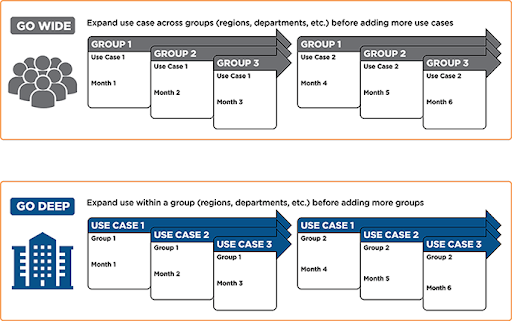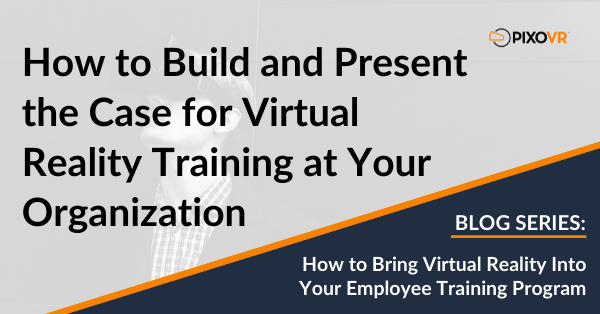The following is an excerpt from our whitepaper: ‘How to Bring Virtual Reality Into Your Employee Training Program’:
Once you have the qualitative and quantitative evidence of the problem you want VR training to solve as well as the proof from research studies and the experience of other companies to show that VR training can indeed solve it, you are ready to build your case to get executive buy-in. The evidence discussed is the “why”, but it is also helpful to put together a plan for the “how”. Meaning, how you will begin to integrate VR training into your program and scale it for maximum benefit.
Your plan for VR training should include:
1) Initial pilot or rollout – a formal pilot is not always needed/warranted to prove that VR training will work for your organization. That said, a slow initial rollout is always helpful to work out the bugs and gain early adopter supporters. The next section covers the details of when a pilot is needed and should be referenced when building this case. You’ll want to include the details of the pilot or initial testing groups, including the use case, number of trainees, timing, and most importantly, what you will be measuring or hoping to accomplish in the early stages of VR training.
2) Plan for expansion – When thinking about a realistic plan for expansion, you’ll need to consider the best way to roll out VR training content to your organization. One approach is to work with one group (such as a department or region) and continue to add different training content to that group, showing maximum impact within a small group. Another approach is to focus on one training module and roll it out company wide to all applicable employees, then slowly add more content. Both are solid approaches. To decide which is best for you, consider the problem you are trying to solve and whether it is a company-wide problem or a problem within a certain job function or department. Once you’ve determined your approach, you can build a realistic timeline based on existing training frequency. As you’ll read later in the section on executing your pilot or first session of VR training, it is best to do it alongside existing training sessions.

3) Key metrics to track – In order to determine the metrics you will track, consider the problem you are trying to solve and the proof you need that VR training is indeed causing improvement. Typical metrics tracked are training scores, time to train, user feedback, and cost. Additional metrics tracked post-training are outcomes of successful training relative to job performance. For example, if VR training was being used to improve worker safety, accidents would be tracked. Or, if VR training is being used to improve worker relations, HR complaints would be tracked.
4) Proof that VR training works – Most executives want evidence that VR training has worked for others to raise their confidence that it will work at your company. There have been quite a few research studies on VR training from universities as well as top consultancies. Additionally, notable companies have shared their successes with VR training. There is a comprehensive collection of statistics on VR training that you can use to pull the relevant statistics that will resonate for your use case.
5) VR cost estimate – Most executives want an understanding of the investment and potential return before signing off on a new idea. This starts with providing an estimate for VR training costs. There are three basic costs for VR training, 1) the headsets, 2) the content, and 3) the software to deploy the content to the headsets, manage the process, and track results. The number and type of headsets needed will vary depending on which approach you are taking and if the headsets will be shipped to different locations. Most companies use a 1:4 ratio for headsets per employees being trained in a classroom setting, 1:1 if remote. Content cost will vary depending on if standard content is used or if custom content is needed. Typically custom content is used if you have proprietary machinery or processes that you are looking to train on. VR training software often orchestrates the content licensing or custom creation so contacting a leading VR training solution provider is a great place to start. They can help you work through what is needed and the associated costs.
6) Simple ROI analysis – Once you have the basic costs, you can combine that with the cost reduction you anticipate from solving the problem you are addressing. For example, if VR training will allow you to eliminate travel costs, machinery downtime costs, shadowing costs, etc. you can list those. If it can reduce costs by solving a business problem like money spent on lawsuits or skilled labor shortage, do your best to present those costs. While you can’t guarantee total elimination of those costs, they are usually quite large compared to the investment in VR and any reduction, even a small one, will yield a high ROI.
Once you have the plan information together in a document or presentation format, you can make your case through the ranks to the business leaders that will support this change.
Tip: Consider involving the key leaders you need buy-in from in helping to identify the biggest problem to solve and the impact to the organization. This will help you to align VR training to the biggest organizational concerns, which will smooth the way for getting their approval when you propose your plan for adding VR to your training program.
Download the whitepaper: ‘How to Bring Virtual Reality Into Your Employee Training Program’


Leave a Reply
You must be logged in to post a comment.